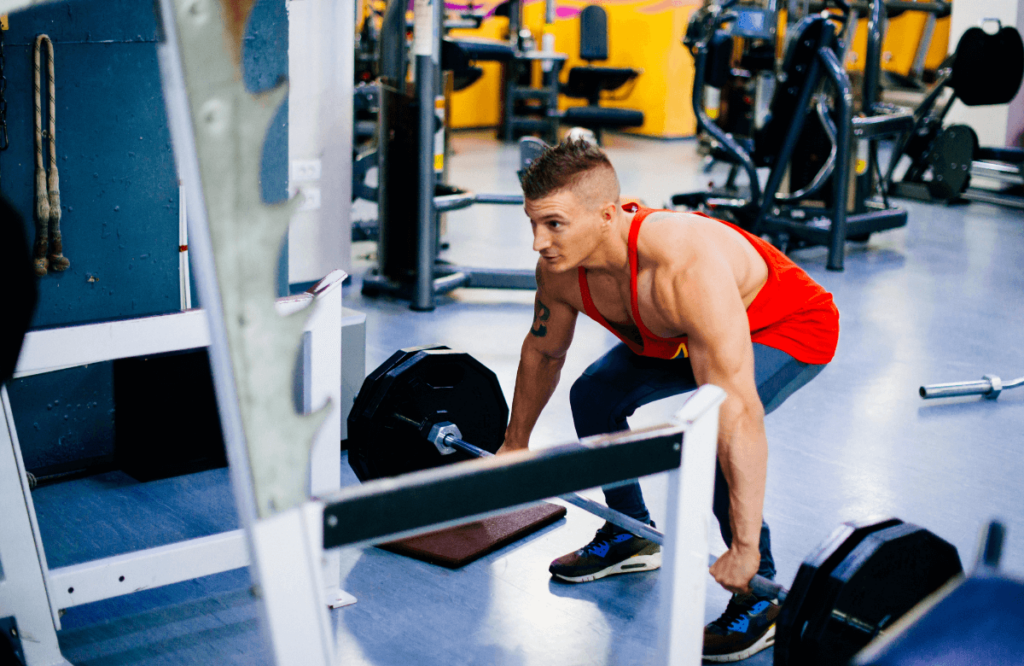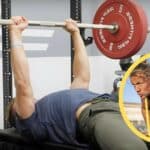Whether you’re an intense conventional deadlift fan or you’re a newbie lifter who wants to see what else there is, look no further! In this article, we’re going to be going over how to overload with block pull deadlifts, how to do this deadlift variation, and why you need to add block deadlifts to your routine to build maximal strength.
And once you learn the proper technique and the benefits behind this deadlift variation all you need is access to blocks of any kind, a barbell, and that’s it, so let’s get started!
Jump to:
- First Off, What are Block Pulls?
- So How Does The Block Pulls Deadlift Differ From The Conventional Deadlift?
- The Muscles Used During A Block Deadlift
- How To Perform The Block Deadlift
- Common Mistakes of the Block Pull Deadlift
- How To Progressive Overload With Block Pull Deadlifts
- Now, Why Should You Overload With Block Pull Deadlifts?
- Similar Exercises To Look In To
First Off, What are Block Pulls?
Block deadlifts or also known as a “block pull” or an “elevated deadlift,” are like a regular deadlift that you’re used to, but instead of the barbell sitting on the ground, it’ll be on some sort of elected surface like weights or heavy wooden blocks. It helps place a bigger emphasis on the lock-out portion of the deadlift and can really assist in getting you an overall, well-rounded deadlift.
The purpose of doing this exercise is to work on your weakness with the mindset that when you go back to a conventional deadlift you’ll be able to lift not only more but more confidently and with better form.
So How Does The Block Pulls Deadlift Differ From The Conventional Deadlift?
Range of Motion and Time Under Tension
With a block pull deadlift, there is less time under tension and a reduced range of motion compared to the regular deadlift. Because of the limited time under tension, there is less muscle fatigue and exertion and instead recruiting more fast-twitch muscle fibers. There are also fewer muscles used in a block pull deadlift as opposed to the conventional deadlift which is considered a full-body exercise.
Stability Requirements
Since your range of motion is less with a block pull deadlift it also requires less stability throughout the movement. This means reduced stabilizer muscle groups (like the core, deltoids, forearms, and calves) and less muscle group fatigue in comparison to the conventional deadlift.

Low-Intensity Workout
With the shorter time under tension, there is less exertion, which makes it a great low-intensity workout. And since there is a lesser range of motion there is less stress on your knees and hips. Unlike the conventional deadlift, the block pull doesn’t require you to bend as low and can be a good alternative for people with joint pain. It also has a lower risk of injury to your spinal column, meaning it can be a great place to start for people with back issues as well.
The Muscles Used During A Block Deadlift
The primary muscles used are the glutes, adductor magnus (the inner thigh), spinal erectors, low back, mid back, traps, and your forearms (your grips). To get a better idea of what you’re using and when you know that in the bottom range of motion, you are focused on the knee extension. Those muscles needed for the knee extension are the quads (for the most part) while the top range of motion is focused on the hip extension to challenge more of the glutes (for the most part). So think, ground-to-knee height emphasizes the quads while knee-to-lock-out is the glutes.
How To Perform The Block Deadlift
First, set up your block deadlift by getting your barbell on either heavy wooden boxes or weighted plates. The bar should be leveled mid-shin (or anywhere between your mid-shin and knee depending on your weakness). This exercise can be done with the barbell from knee height, just be careful about not going too high that you lose the benefits of the exercise.
Next, get the middle of your feet under the bar, hip-width apart, and then grab the bar with your hands just outside your thighs.
When you’re lifting, imagine pushing with your legs and feet to the floor instead of “pulling” and remember to keep the bar so close to your legs that it should be dragging against your shins and knees. If it’s starting to rub or become uncomfortable try wearing long pants, leggings, or high socks when practicing this exercise.
Aim to keep your shoulders directly in line with the bar and your back neutral to get a slight natural forward lean. There will also need to be a small bend in your knee but it’s important to remember that it’s not a squat so don’t overextend.
Common Mistakes of the Block Pull Deadlift
Wrong Set-Up And Not Looking For The Weakness
The number one mistake when it comes to block pull deadlifts is the height options. Many people go too low or far too high, resulting in poor posture and not getting the actual benefits of the exercise. A lot of people when doing this deadlift variation avoid looking for their weak spot and just lift it from a recommended weight and call it there. To get the most out of the exercise you have to try different levels to find the correct height for you. If you have trouble lifting at mid-shin then lift more at mid-shin, if you start to fail at an inch below your knee, practice with your starting position at an inch below your knee. This isn’t an exercise just “to-do,” it’s one that’s here to aid you and get you to accomplish your goals faster.
Using Heavier Weights
This exercise targets a smaller group of muscles and while it might seem like it’s easier than the conventional deadlift, it’s important to remember not to get too heavy when lifting. If you’re not starting at your weakest point and trying to lift heavier than your standard deadlift load you’re not going to see results as fast with this exercise variation as you would if you went to a lower weight and found your proper starting position while keeping the proper block deadlift technique. So be very careful here!
How To Progressive Overload With Block Pull Deadlifts
Technically any partial range of motion exercise such as the block pull is considered an overload training method. This means for this exercise you likely won’t be able to use the same load you would for the full range of motion exercise. A good example is if you lift 500 lbs for 5 reps on the regular deadlift, but your block pull load is 450 lbs for the same amount of reps. This sets you up perfectly for overloads by starting at a lower weight and slowly increasing.
If you don’t know, progressive overloads are when you slowly increase the frequency, weight, or number of repetitions in your strength training routine. So for block pulls, you’ll likely pick a weight under your normal deadlift load and then gradually build your way up.
If you’re already applying this technique to your daily routine then simply add the block pulls in by starting at the highest weight you can do without breaking proper form at a manageable rep count. If you’re not used to overload exercise, start with just the block pull. Pick a comfortable weight and rep count and have a plan that every five to seven days you’re going to up the weight or rep count. We recommend you have a notebook or a workout tracker app to keep your numbers consistent and then do that for a minimum of five weeks to get the best results.

Now, Why Should You Overload With Block Pull Deadlifts?
The Psychological Benefit
It’s not uncommon to stress about lifting heavier loads, so if this is you or you feel as if you’ve reached a plateau in your deadlift training, progressive overloading could be your saving grace. After each week of slowly increasing weight, it’ll help build confidence and be way less intimidating than going from a lower to a much higher weight to build maximal strength. It’ll also keep you motivated since you can see the progression and you’re not just guessing or wondering what your average block pull deadlift load is.
Safer Lifting
Progressively increasing your weight or reps for e block pull deadlift is going to be way safer than going from 5 to 15 reps after one day. Overload training like this is great at conditioning your body and preparing it for more. Of course, the number of the rep/weight increase number is up to you, but we recommend going up only 1-2 reps or 5-10 lbs a week. If you go too high (even if you think you can lift more) leaves you at a higher risk of injury and if you’re older or have health issues this can set you back in your training.
Similar Exercises To Look In To
Deficit Deadlift
The deficit deadlift has the same idea as a block pull deadlift, instead of the barbell being on the elevated surface, you are, and the barbell is on the floor.
Rack Pull
The rack pull had the same movement pattern and mechanics of a block deadlift, except a rack pull is done on a squat rack, power cage, or barbell rack ideally with the barbell at knee height.
Romanian Deadlift
This Romanian deadlift is very similar to the conventional deadlift, except you’re going to lower the bar to just below your knees and back up to the top position over and over again until your set is done without putting it down.
Conventional Deadlift
The conventional deadlift exercise is likely what you’re most familiar with, which is lifting up the barbell from the ground and extending to a standing position while keeping the correct form.














